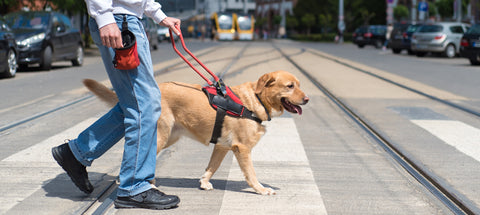Let’s start at the beginning – why do dogs bark?
The answer is simple: it’s instinctive and natural. Alongside whines, growls and whimpers, barking is a form of canine communication that traces back to our domesticated dogs’ wild ancestors. However, domestic dogs share our homes, so lots of barking can become a real headache for human families (and their neighbors!).
Dog barking – the basics
If you’ve recently welcomed a new puppy or rescue-dog into your home, it’s a good idea to brush up on the basics of dealing with a barking dog:
- If your dog starts barking, try to tackle the behavior quickly with positive training – if you just ignore it, it’s likely to escalate.
- Try not to encourage your dog to bark in certain situations and not in others – it’s easier for your dog to understand what’s required if you’re consistent.
- If you want to ‘train’ barking – perhaps for security reasons – always train with a command such as ‘speak’, so your dog understands when it’s appropriate to bark.
- Never shout at your dog when they bark excessively – this makes your dog think you’re joining in with the fun or share their fear. Instead, speak to them with a calm, firm voice.
Why do some dogs bark more than others?
There are many factors that influence how much your dog barks. These include genetics, socialisation, training (deliberate or accidental!) and the behavior of other dogs who share the home or live close by. Regardless of the root cause, there are 6 main kinds of barking:
- The attention seeking bark
- Boredom, loneliness or separation anxiety
- Greeting barking
- Territorial or alarm barking
- Play barking
- Contagious barking.
Let’s take a closer look at these kinds of barking including the causes, and how you can work with your best friend to modify their behavior.
-
The attention seeking bark
Us humans like to chatter, so it’s no surprise that our dogs like to use vocal communication to let us know what they want, too. However, if you train your dog to bark when they want something – be that a treat, playtime, or to go outside – you can end up with a demanding, attention seeking barker.
Reducing attention seeking dog barking:
The best way to avoid attention-seeking barking is not to encourage it in the first place. Well-mannered dogs wait for their owners to offer treats or instigate play – they don’t demand! If it’s already too late, then it’s back to puppy school for your doggie dictator. When they bark at you to demand play, food or attention, ignore them – and make sure every member of the family does the same. It helps to cross your arms and turn your back, stare at the ceiling, or walk away. Then, once the barking stops and your dog is quiet, reward your dog with a treat and add the command “quiet”. Eventually, they’ll stop demanding, and start responding when you ask them to be quiet.
Top tip: consider a doggie doorbell to help your dog communicate without the dreaded bark.
-
Bored, lonely or anxious barking
Do you have a dog who’s feeling lonely at home? Separation anxiety, boredom and loneliness are common causes of excessive dog barking. As pack animals, our dogs don’t always cope well spending long days home alone – and can resort to barking to break up the boredom and express their discomfort. Other dogs become fearful and anxious when separated from their human families and will bark to call the pack back.
Helping dogs who bark because they’re lonely:
If the barking is recent, a pragmatic approach can be helpful. Make sure your dog is tired out with plenty of exercise before you leave them home-alone and try to pop home during your breaks for playtime or walkies or ask a friend to visit. If that’s not possible, consider a dog walker, doggie day-care, or even a pet-sharing service like BorrowMyDoggy. Food dispensing toys can be great boredom breakers too. If you ignore the early signs of boredom and loneliness, it can develop into something more serious: separation anxiety. Remember, if your dog is pacing, becoming destructive, or having accidents when you leave them home alone, it’s time to talk to your vet for expert advice.
-
Greeting barking

This type of barking is signalled by tail-wagging, excited wiggling, jumping, and whining. It’s great to see your dog so happy to see other dogs or family members, but if their greetings are a bit much for you – or your visitors – it’s easy to train them to say hello more politely.
‘Stay on the spot’ training for over-enthusiastic greeters:
It’s easy to train your dog to go to a spot and stay there when the door opens. Here’s how:
- Choose a spot. This should be somewhere in view of the door, but not too close to it.
- Place treats on the spot, and when your dog goes over to eat them, add the command “on your spot”.
- Practice, practice, practice!
- Once you have your dog going to their spot-on command, start opening the door whilst they are there. Keep the treats coming, but only when they remain on their spot.
- Once you can open the door whilst they stay on the spot, get a friend or family member to help by knocking on the door while you use the command and treat.
- Repeat with a few different visitors – the visitor can also treat, but only if your dog sits calmly on their spot.
- You now have a polite greeter!
Clicker training can speed up the process – find a good guide to the basics here.
-
Territorial or alarm barking
This is your dog warning you – and the encroaching animal or person – that they have entered the area your dog considers to be their territory or ‘personal space’. At home, some owners find this useful as a deterrent or warning of visitors. However, alarm barking can also happen out and about when your dog finds something (or someone) scary or unnerving.
Reducing territorial dog barking:
This type of barking can be reduced by limiting what your dog sees. When your dog is inside, you can reduce their access to windows and doors by drawing curtains or shutting blinds. If outside, make sure your garden fencing doesn’t have gaps or holes.
Reducing your dog’s alarm barking:
If you’d like to reduce your dog’s alarm barking when out and about, you can use the “quiet” training technique detailed earlier. However, it’s important to be aware of why your dog is alarm barking – and not to abuse the “quiet” command to make them tolerate situations which they might be unhappy in. Remember that alarm barking is a warning that your dog is feeling afraid or uncomfortable, so if you suppress their behavior and don’t make positive changes to help your dog feel more comfortable with the situation they may try a different kind of behavior: growling, snapping or even biting. If alarm barking happens often, it’s a good idea to talk to your vet or behavior expert for advice to help your dog feel more confident out and about.
-
Play barking
It’s natural for dogs to bark and growl at each other (or you) when they play. This is totally normal and natural, and we wouldn’t recommend trying to modify this dog behavior - they’re barking for joy, after all! However, be mindful that when it’s playtime between people and dogs, there can be a fine line between play barking and attention seeking barking. Keep an eye on it and ensure that you’re the one who chooses to initiate and end play, so you don’t end up with a pushy playtime partner.
-
Contagious barking
This is a very natural and normal behavior – the sunset serenade of the neighbourhood hounds! If you live in an urban area, it’s common that one dog’s barking ‘sets off’ all the local dogs. If you’ve trained a “quiet” command, it can be useful to employ in this situation to stop your dog joining in.
Does your dog bark excessively? Do they ‘speak’ in other ways? We love to hear about your adventures with your pets, so please do leave a comment and tell us more about your doggie conversations, and join our friendly pet-loving community on Facebook and Instagram.










